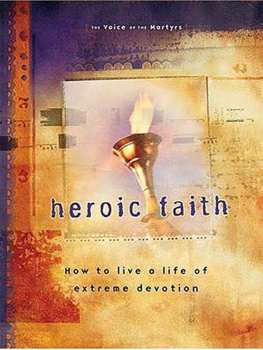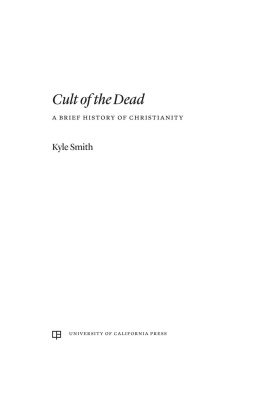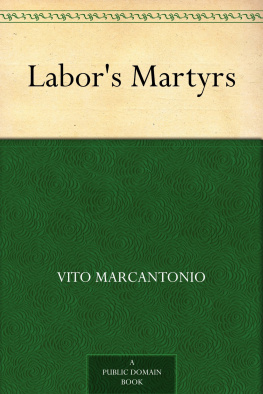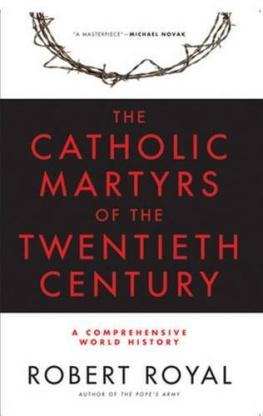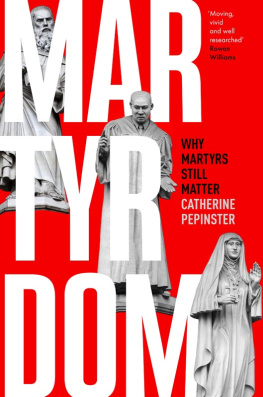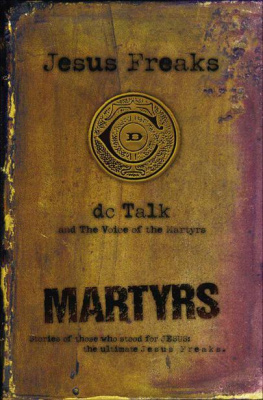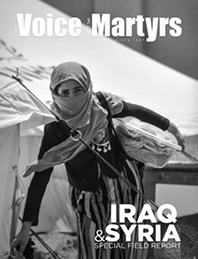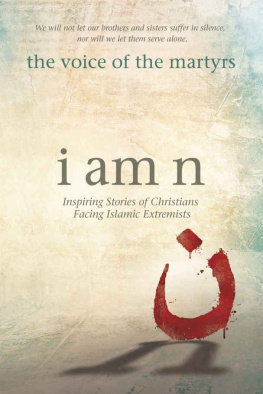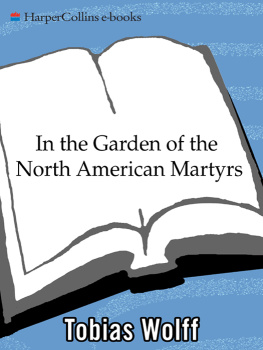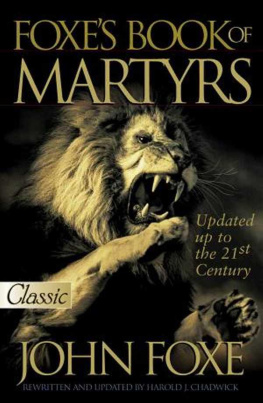Table of Contents
Unless otherwise noted, Scripture passages have been taken from the Revised Standard Version , Catholic edition. Copyright 1946, 1952, 1971 by the Division of Christian Education of the National Council of Churches of Christ in the USA. Used by permission. All rights reserved.
Cover design by Candle Light Studios
Cover images: Ann Glover, Thomas Slatterwhite Noble 1935-1907, Collection of the New York Historical Society, 1988; Leo Heinrichs, photo courtesy of Wikimedia Commons; Kateri Tekakwitha, photo courtesy of Wikimedia Commons; Nykyta Budka, photo courtesy of Wikimedia Commons; Vasyl Velychkovsky, photo courtesy of Bishop Velychkovsky Martyrs Shrine, www.bvmartyrshrine.com; Francis Ford, M.M., photo courtesy of Maryknoll, www.maryknoll.org/timeline_images/1951_BpFord.jpg; Emil Kapuan, photo courtesy of Wikimedia Commons.
Book design by Mark Sullivan
Library of Congress Cataloging-in-Publication Data
ONeel, Brian.
150 North American martyrs you should know / Brian ONeel.
pages cm
Includes bibliographical references.
ISBN 978-1-61636-551-6 ( alk. paper)
1. Christian martyrsNorth AmericaBiography. 2. CatholicsNorth AmericaBiography. I. Title. II. Title: One hundred fifty North American martyrs you should know. III. Title: One hundred and fifty North American martyrs you should know.
BX4655.3.O5423 2013
272.09227 dc23
2013037602
Print ISBN 978-1-61636-551-6
E-Book ISBN 978-1-61636-552-3
Copyright 2014, Brian ONeel. All rights reserved.
Published by Servant Books, an imprint of Franciscan Media
28 W. Liberty St.
Cincinnati, OH 45202
www.FranciscanMedia.org
To those who experience martyrdom today:
You are not forgotten!
Acknowledgments
Thanks to Louise Par for conceiving this books theme, and to her and Claudia Volkman for their incredible guidance. Thanks to Rosalie Grady at Downingtowns library. I kept her busy, but she always came through.
To my familyespecially my wifefor their patience and forbearance. Also especially to my toddler son and constant companion, Liam. He made my work much less efficient. However, I wouldnt change a nanosecond of our time together. It was magic, and I thank God for what a great gift he is.
Finally, thanks to all who read the previous books. Youre the reason this book exists (well, that and Gods grace, of course).
Introduction
I hope you get two things from this book.
One is that many of the factors that led to these martyrdoms are by and large still with us. For instance, the state penalizes people for explaining pan-Christian moral teachings. In March 2013 the Canadian Supreme Court ruled that William Whatcotts fliers opposing homosexual practices constituted hate speech. Police in both Canada and the United States have arrested peaceful pro-life protestors, including a grandmother who simply sprinkled holy water on a sidewalk outside an abortion clinic. There are also numerous lawsuits against Christians who simply want to live according to their beliefs. In our increasingly secular society, Christians face serious opposition to their faith, which conceivably could escalate.
There has been no loss of life yet, but we must wonder: Are the foundations for that unfortunate possibility being laid? As Pope Francis said in April 2013, The age of martyrs is not yet over. Regardless, as several popes have made clear, we Christians cannot let such realities inspire fear in us. Indeed, fear is from the devil. Instead we must be not afraid. As we learn in the chapter on Servant of God Emil Kapaun (chapter twenty-five), hope is the only option in a dark and troubled world.
The other point you can take from this book: Everything you know about the history of the Catholic Church in North America, throw it out. Just toss it in the can.
Hmmm. On second thought, scratch that.
Why the ambiguity?
Its born of the fact that when I was asked to write this book, my first thought was, North American martyrs? Thats St. Isaac Jogues and company. Beginning of story, end of story.
That isnt the case though. You see, the first of those we traditionally think of as the North American martyrs was St. Ren Goupil, who perished in 1642. The first martyr on North American soil, however, died in 1542, one hundred years before. And one of the first persons executed on this continents soil for being a witch was a resident not of Salem, Massachusetts, but of Boston. Her name was Ann Glover. She was a Catholic, and she was decidedly not a witch.
The men commonly known as the North American martyrs werent even the first to die in Canada. That distinction belongs to Fr. Nicolas Viel, a Recollect priest who underwent a watery martyrdom along with an Indian named Ahuntsic in 1625.
Furthermore, mortal persecution didnt end with colonial times. A few years ago we passed the centennial of the martyrdom of a priest in Colorado, and we will soon reach the hundredth anniversary of the shooting of an Alabama priest by a fundamentalist minister. Then there are the many who died in Christs service overseas.
But what about the North American story not being what you think it is (unless, of course, youre a serious student of this continents history and the Catholic Churchs role in it)? Whether its the tolerance for which Canada is so famous or the real reason behind the American Revolution and the aptly named Know-Nothing Party, the answer to that question will unfold as you read this book.
Some of this is wicked, gruesome stuff, but compelling, awe-inspiring, and inspirational, too. So settle into your favorite chair (or even into your favorite pew at the adoration chapel), pour a cup of coffee or tea (not in the adoration chapel, mind you), relax, and enjoy.
The Columbian Era
In 1519, and in the name of Christ and the Spanish crown, Spanish adventurer Hernn Corts conquered the Aztecs and thus Mexico, renaming the territory New Spain. After the apparitions of Our Lady of Guadalupe to St. Juan Diego in 1531, Spanish missionaries in Mexico received millions of indigenous into the Church in the span of just a few years.
It took another two decades for the Spaniards to attempt evangelization of the land north of the Rio Grande River we now call the United States. Alas, these efforts were more challenging. The first permanent mission didnt exist for another thirty years. In 1565 the Spaniards established Floridas always-troubled Mission San Augustn. Spanish efforts never progressed north of Virginia.
Despite some impressive conversions here and there, various orders abandoned Florida in succession because of often-violent native opposition, French Protestant harassment, or some combination thereof. The Spaniards erected a network of missions in New Mexico, but these closed after a late-seventeenthcentury revolt. Arizona bore little fruit until the Servant of God Fr. Eusebio Kino, s.j. (d. 1711), began settling missions there, of which there were eventually dozens.
As for Canada, the first of many French attempts to colonize the area north of the St. Lawrence River took place in 1534. However, every effort to establish a permanent settlement failed until 1608, when settlers founded Qubec. Even that settlements survival was never a sure thing. Savage Indian attacks, disease, and poor harvests all contributed to New Frances touch-and-go viability. However, the French persevered and built a thriving colony.
As with the French colonists, so it was with their missionaries. After initial troubles they converted the Algonquin Federation and the Huron tribe, not to mention Maines Wabanaki nation. However, the Iroquois proved almost universally unreceptive to the Gospel. This caused problems because the Iroquois were the most numerous and hostile of all the Indian confederacies. (For the purpose of clarity, the five tribes comprising the Iroquois Confederacy were the Mohawk, Oneida, Onondaga, Cayuga, and Seneca nations.)


